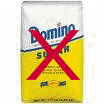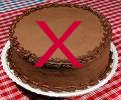
|
◊◊◊◊
About sugar and other sweeteners
See more information about sugars on the Controversies Page
◊◊◊◊
Go to recipe lists at bottom of page
◊◊◊◊
|
Getting refined sugar out of your diet
Refined sugar is probably the worst "food" you can put into your body. The chemical reaction of sugar in the body sometimes acts as a poison does (but technically it is not). Studies show that sugar has a drug-like effect in the body (but is technically not a drug).
However, sugar is an addictive food, and abruptly giving up sugar can sometimes bring on withdrawal symptoms.
For most people, weaning off sugar gradually is the best way—and for some the only way—to kick the sugar habit. Going cold turkey can make you feel like you're denying yourself and could cause you to binge, sending you back to using refined sugars. The goal is long-term change. Here is something I came up with, including some replacement ideas that might help to get through each stage.
This is about cutting refined sugars from the diet. Do not cut out fruit and vegetables and other good, wholesome foods that have naturally-occurring sugars (foods which are necessary for good health—the body needs the nutrients found in these foods).
These are my suggestions. Do what works for you, in any order that works best for you, and to whatever degree you desire to eliminate sugars.
Steps toward gradually eliminating refined sugars and other refined foods.
1. Stop drinking sugar-sweetened sodas and soft drinks.
Replacements: Water, club soda, tea, herbal tea, chai tea, lemonade, limeade—preferably unsweetened. At this point, you can temporarily switch to using diet sodas to help in the transition, and eliminate these in Step 7. However, it's best to eliminate them now, because research has shown that the use of diet drinks leads to weight gain.
2. Start reducing the amount of sugar you use in coffee and tea, until they taste good with none. Also, switch to decaf or limit caffeine to 2 cups per day.
Replacements: Preferably none—learn to like these unsweetened. However, you can switch to sugar substitutes and natural sweeteners at this point. These can be eliminated, if desired, in Step 7.
3. Cereals—Start reducing the amount of sugar you use in hot cereals until they taste good with none. Eliminate cold cereals that have added sugars.
Replacements: Preferably none—learn to like these unsweetened. Read labels, and only buy cereals without added sugars. However, you can switch to sugar substitutes at this point, and eliminate them in Step 7, if desired. For some natural sweetness in cereal, eat some fruit with it.
4. Eliminate desserts and snacks made with refined sugars. This would include candy, cookies, cakes, pies, doughnuts, ice cream, etc.
Replacements: Your best dessert is fruit. However, you could also eat home-made or purchased desserts made with sugar substitutes (such as puddings and no-sugar-added ice cream). You can eliminate these, if desired, in Step 7.
5. Eliminate other foods that contain refined sugars that are sometimes called “hidden” sugars.
This includes breads, crackers, waffles, salad dressings, marinades, peanut butter, pasta sauce, salsa, frozen foods, and many others. To an extreme, this would also include spice mixes. Read labels of everything you buy. Avoid any product that lists sugar, corn syrup, high fructose corn syrup, and any other refined sugars in the ingredients list. Natural sugars are okay.
Replacements: You can buy sugar-free versions of these products, or buy those made with natural sweeteners, not refined sugars. You can eliminate natural sweeteners, if desired, in Step 8.
6. Eliminate all other refined and processed white foods such as white enriched flour, white pasta, and white rice.
These are refined, starchy grains with little or no fiber and are quickly converted to sugars during the digestive process.
Replacements: Whole grain flours (whole wheat flour, buckwheat, spelt, soy, and others), brown rice, 100 percent whole wheat or other whole grain breads, whole wheat or other whole grain pasta, and whole grain cereals, all without added, refined sugars. You might have to do some searching to find appropriate breads. Read labels.
At this point, you've eliminated refined sugars and refined grains. If this is your goal, you've arrived. If not, continue with the next steps.
Although artificial sweeteners and sugar substitutes do not raise blood sugar levels like refined sugars and grains, they are believed by many to be harmful to your health. However, not everyone believes that all of them are harmful. (See my Controversies About Foods page.) Decide for yourself, and continue on to Step 7 if you want to eliminate these. If not, skip this step and go to Step 8.
7. Eliminate or reduce consumption of artificial sweeteners and/or sugar substitutes, including diet sodas, gelatin-type products such as Jell-O, pudding mixes, etc. Read labels carefully. There is controversy about which of these sugars are safe and which are not. Research them, and decide for yourself. See above link for help. As stated in Step 1, drinking diet sodas actually leads to weight gain, probably because they stimulate your appetite, so they would not be a wise choice even if the sugars were not harmful in other ways.
Replacements: Natural sugar substitutes such as Stevia (a sweet herb), Erythritol, or Xylitol. Or natural, whole food sweeteners such as organic unsulphured blackstrap molasses, raw unheated honey, and pure maple syrup. See the Sugar Page for details and other suggestions.
8. Eliminate natural sweeteners only if they cause a problem for you (such as high blood sugar, low blood sugar, weight gain).
Replacements: None. Natural sweeteners are superior to all other sweeteners.
Naturally sweet foods and food sweeteners have beneficial nutrients and have claims to healing properties. However, they are high in calories, so if you are trying to lose weight or if you have a physical problem such as diabetes or hypoglycemia, you will want to use them in moderation, if at all according to how they affect you. If these are not a problem for you, continue to use them and go on to the next step, if desired.
~~~~~~~
Most people will stop here—if not before. However, if you have diabetes or hypoglycemia, you might want to go on to the next step and reduce consumption of the high-sugar fruits and starchy vegetables. Others should be able to enjoy them in moderation, and some people with diabetes or hypoglycemia can also enjoy them in moderation. Do what works for you.
9. Eliminating or reducing some of the high GI foods.
a. Eliminate or reduce consumption of the high GI fruits (meaning those high in natural sugars). Continue to eat the lower GI fruits.
b. Eliminate or reduce the consumption of starchy vegetables. This includes potatoes, carrots, beets, pumpkin and other winter squashes, and corn (a grain often used as a vegetable).
There are many Web sites and books that have GI charts. If you compare some of them, you’ll see that they vary with their numbers, sometimes by quite a bit, so keep that in mind when looking for the GI of a specific food. Also, if you eat a high GI food along with low GI foods, it will reduce the glycemic load (GL) of the meal or snack, which is really what counts, so you can still enjoy these wholesome, healthy foods.
|




